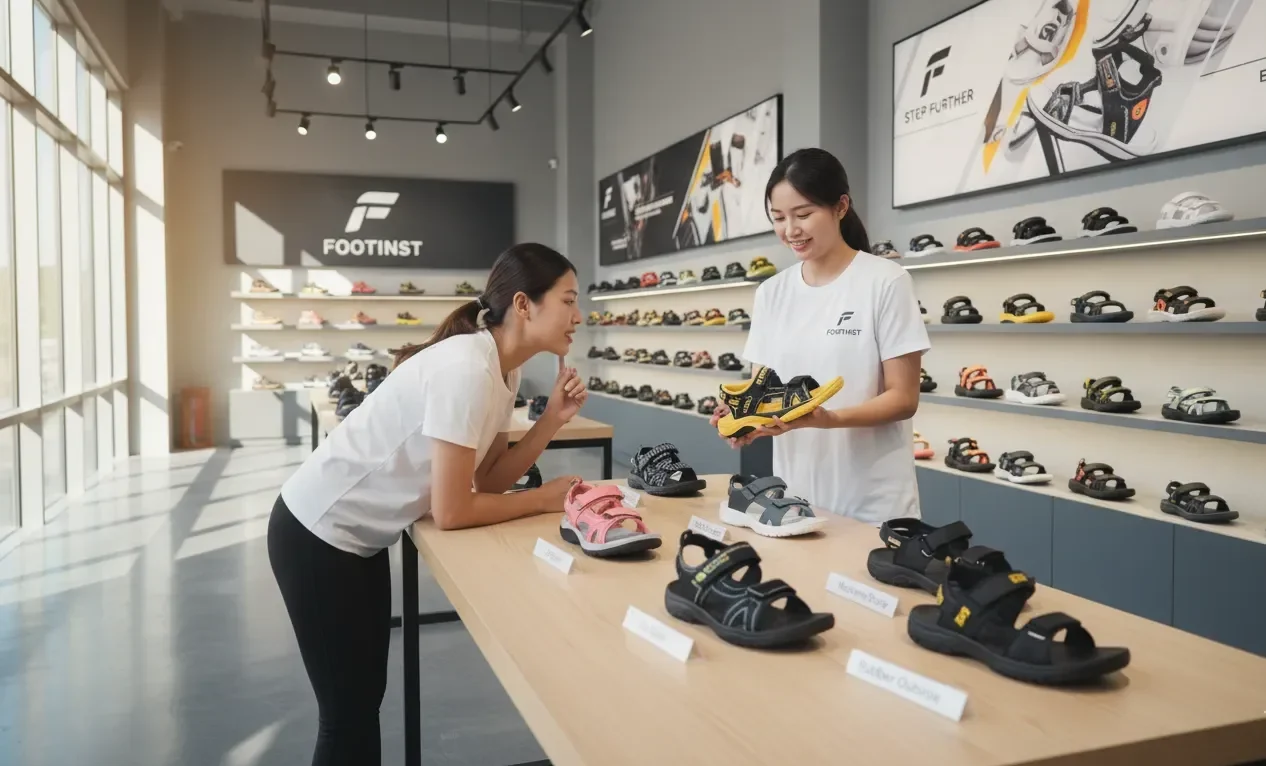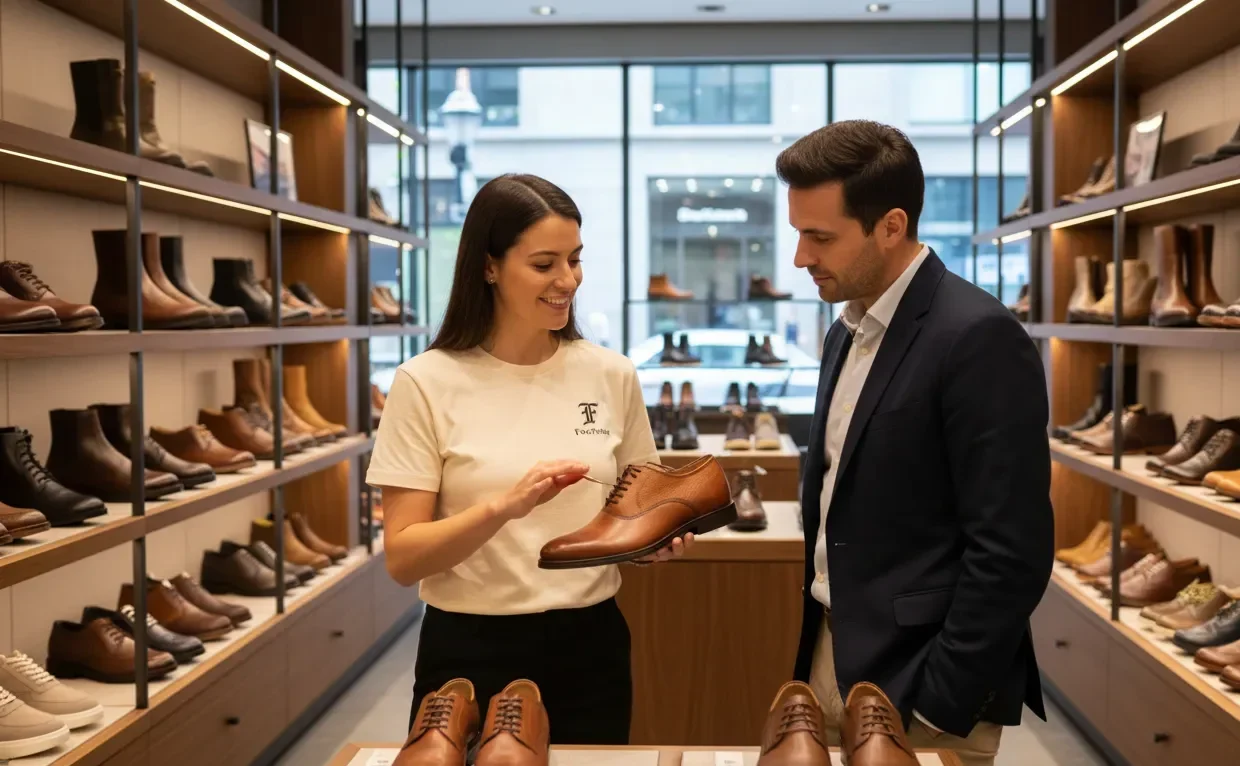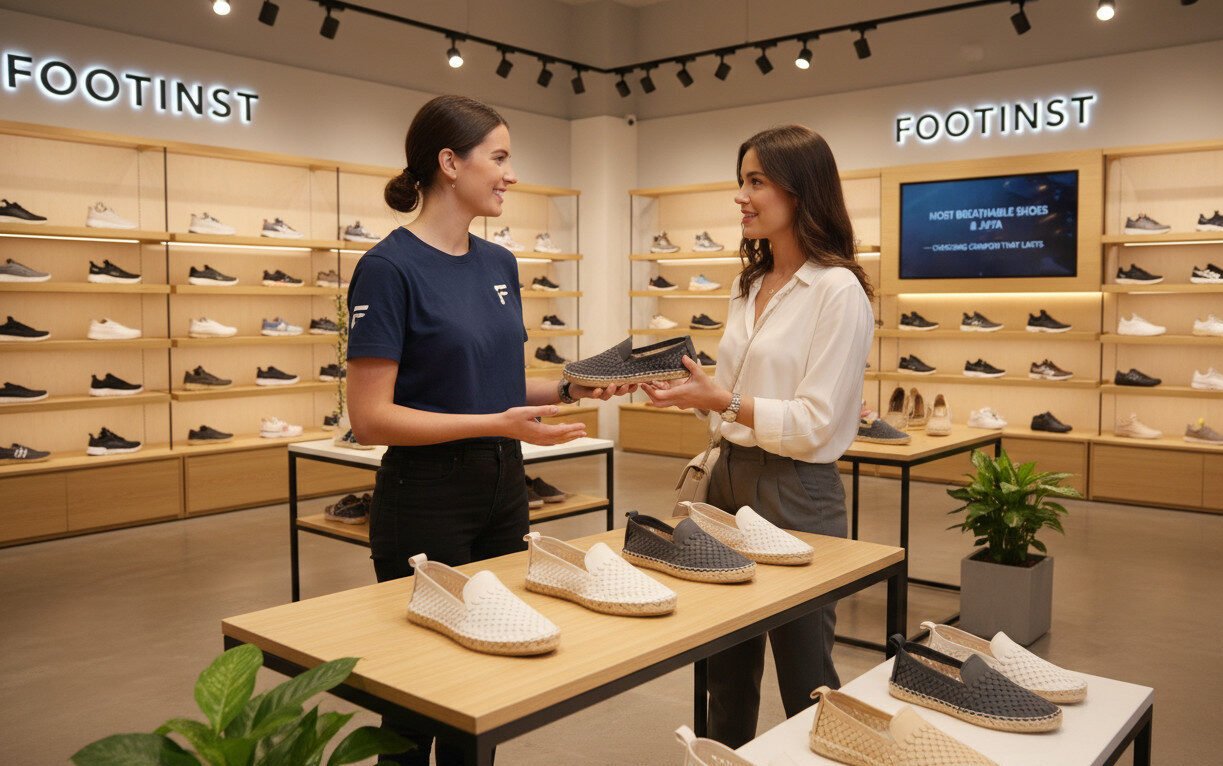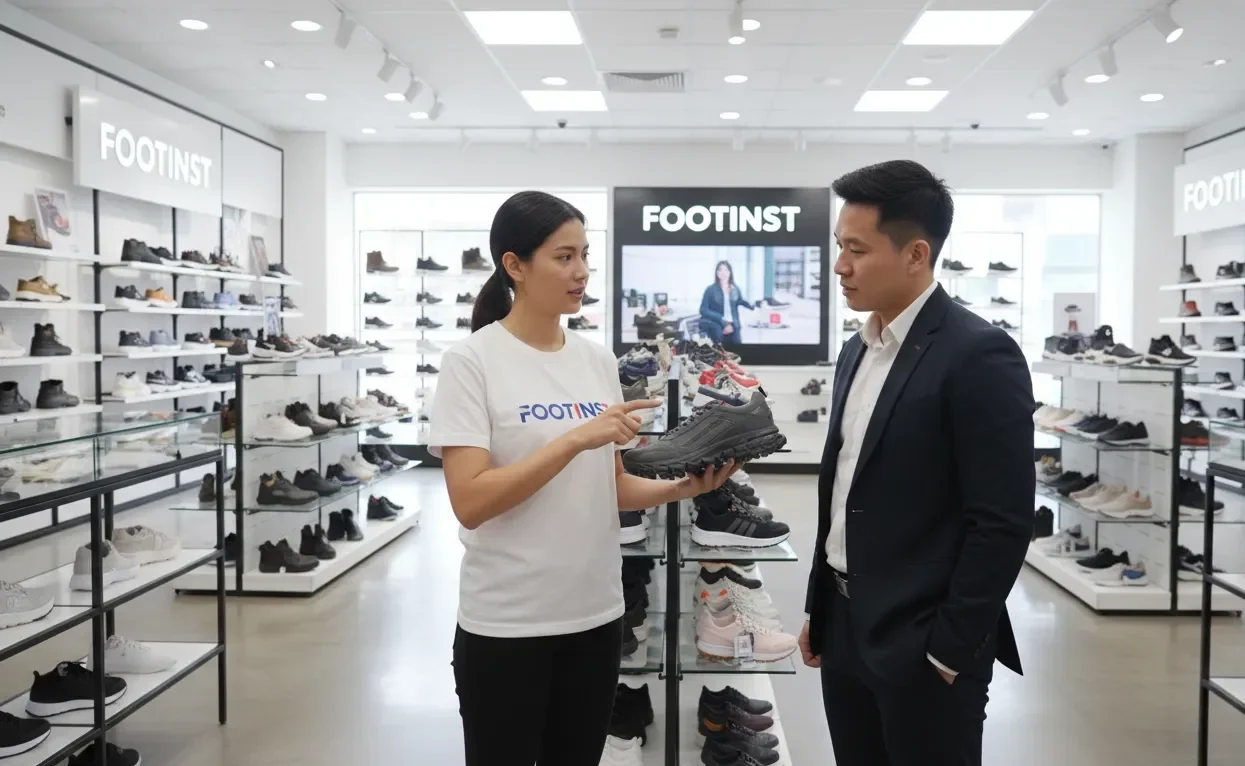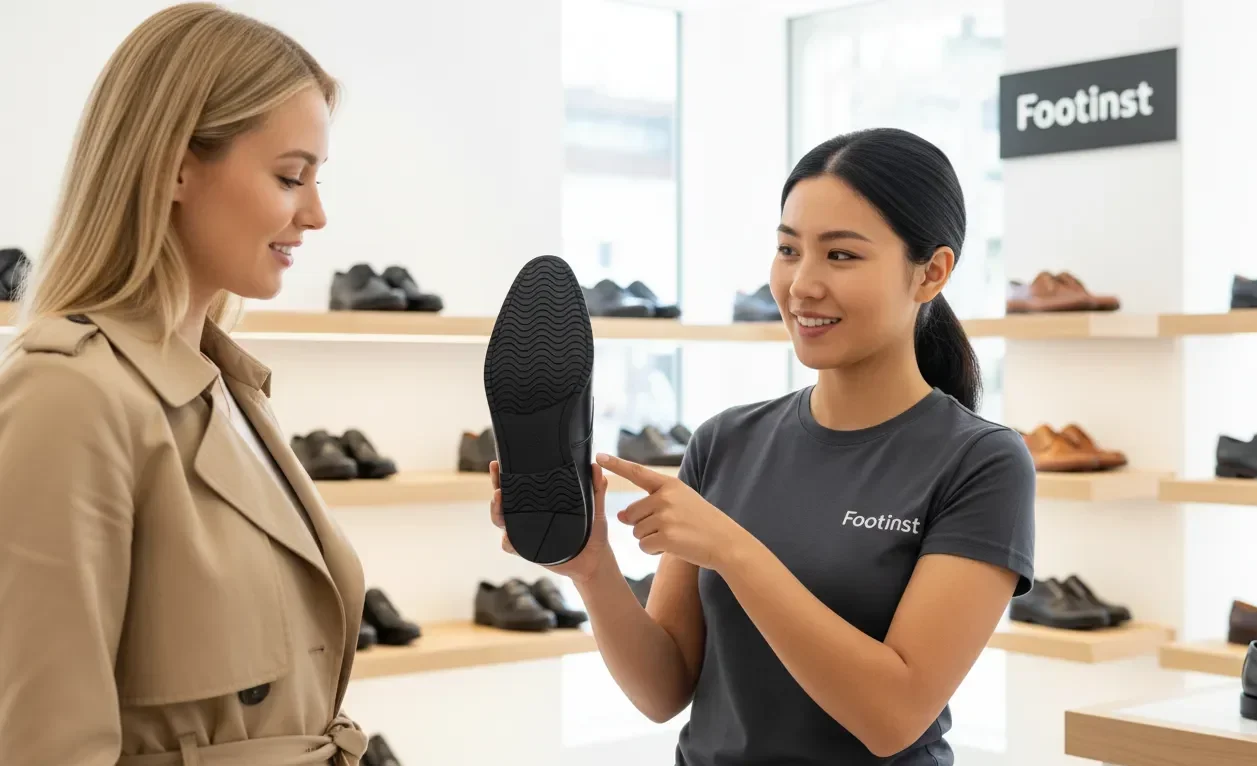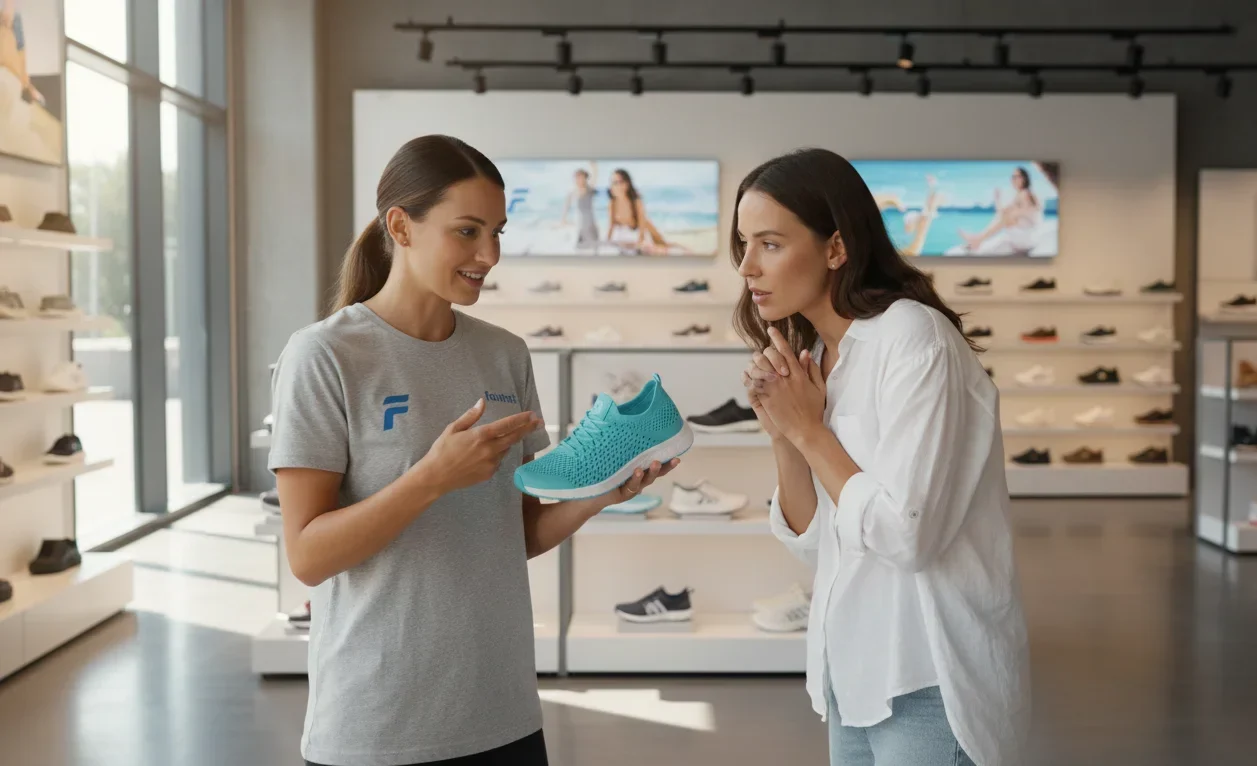Best Insoles for Standing All Day: Expert Comfort Guide for Work Shoes, Sneakers & Boots
Your Feet Hurt After Standing All Day
Standing for long hours can be surprisingly hard on your feet, even if you’re wearing quality shoes or sneakers. From retail staff to teachers, chefs to warehouse workers, many people face foot fatigue, heel pain, and discomfort during a long day. Understanding why your feet hurt is the first step to choosing the best insoles for relief.
Common Causes of Foot Pain While Standing
Poor Arch Support: Flat feet or high arches can cause uneven weight distribution, leading to heel or ball-of-foot pain.
Hard Shoe Soles: Shoes or sneakers with thin or rigid soles fail to absorb pressure effectively.
Fatigue & Circulation: Standing for hours reduces blood flow to feet and legs, creating soreness and swelling.
Improper Shoe Fit: Shoes that are too tight or too loose increase friction, causing blisters and discomfort.
- Footwear Material & Design: Sneakers, boots, or casual shoes with stiff uppers or inadequate cushioning may add strain.
Key Takeaway
Understanding why your feet hurt is crucial. Identifying pain points and material weaknesses in shoes helps you select insoles that provide long-lasting comfort for standing all day.
Real Store Experience Insight
“In my 20+ years in shoe retail, I’ve noticed that customers often complain about pain after just a few hours of standing, even in premium shoes. The root cause is almost always poor arch support or insufficient cushioning. Recommending the right insoles immediately makes a huge difference in comfort.” – Shoe Specialist
Signs Your Feet Need Better Support
- Soreness at the heel or ball of the foot after 2–3 hours of standing.
- Swollen feet or ankles by the end of the day.
- Persistent fatigue in calves or knees, not just feet.
- Blisters forming even when shoes fit properly.
Practical Example
Imagine a nurse working a 12-hour shift: without supportive insoles, even high-quality sneakers may cause foot fatigue by mid-shift. Adding a cushioned, arch-support insole reduces heel pressure, prevents soreness, and improves overall endurance.
Insoles 101 – Materials and Types Explained
Choosing the right insoles can make a huge difference when you spend hours standing. Not all insoles are created equal, and the material and design play a major role in comfort, support, and durability.
1. Gel Insoles
- Best For: Shock absorption and heel pain relief.
- Material: Soft, flexible gel cushions distribute pressure evenly.
- Pros: Reduces fatigue, comfortable for all-day standing.
- Cons: Can flatten over time; may need replacement every 6–12 months.
Pro Tip: Ideal for retail staff, teachers, and anyone on hard floors.
3. EVA Foam Insoles
- Best For: Lightweight, long-lasting cushioning.
- Material: Ethylene-vinyl acetate foam; soft yet resilient.
- Pros: Shock absorption, stable support, moisture-resistant.
- Cons: Less contouring than memory foam.
- Tip: Perfect for warehouse workers or standing on concrete for long hours.
5. Anti-Fatigue Insoles
- Best For: Standing all day on hard floors (retail, restaurants, factories).
- Material: Layered foam or gel with built-in support.
- Pros: Reduces leg and foot fatigue, distributes pressure evenly.
- Cons: Bulkier; may not fit all shoe types.
- Pro Tip: Check shoe depth before buying to ensure a proper fit.
2. Memory Foam Insoles
- Best For: Custom molding to foot shape.
- Material: Viscoelastic foam that adapts to your foot contours.
- Pros: Excellent cushioning, reduces hotspots, lightweight.
- Cons: Less durable under heavy use; can compress over time.
- Store Insight: Customers love memory foam for sneakers and casual shoes.
4. Orthotic Insoles
- Best For: Arch support, flat feet, or high arches.
- Material: Rigid or semi-rigid plastics, sometimes topped with soft cushioning.
- Pros: Corrects posture, prevents overpronation, reduces strain on knees and back.
- Cons: Slightly firmer; may require adjustment period.
- Real Example: A nurse with plantar fasciitis found relief after switching to semi-rigid orthotic insoles in her sneakers.
Expert Insight
“Many customers don’t realize that material matters as much as size. Gel and memory foam are great for daily comfort, while orthotics solve long-term foot problems. Matching insole type to your shoe and standing activity is the key to all-day relief.” – Shoe Retail Specialist
Quick Comparison Table – Insoles
| Insole Type | Best For | Pros | Cons |
|---|---|---|---|
| Gel | Shock absorption | Soft, reduces heel pain | Flattens over time |
| Memory Foam | Custom comfort | Adapts to foot, lightweight | Less durable for heavy use |
| EVA Foam | Long-lasting support | Stable, moisture-resistant | Less contouring |
| Orthotic | Arch support | Corrects posture, reduces strain | Firmer feel, adjustment needed |
| Anti-Fatigue | Standing on hard floors | Distributes pressure, reduces fatigue | Bulkier, needs proper shoe depth |
Choosing the Right Insoles for Your Work Shoes or Sneakers
Not all insoles work for every job or shoe type. The right insole depends on your daily activity, shoe style, and personal foot needs. Choosing wisely prevents fatigue, reduces pain, and keeps you comfortable from morning till evening.
1. Retail and Office Workers
- Challenges: Standing on hard floors, walking short distances frequently.
- Best Insoles: Gel or anti-fatigue insoles for cushioning and pressure distribution.
- Tip: Look for slim-profile insoles to fit in formal shoes or flats without crowding toes.
Example: A store associate switched from basic foam insoles to gel inserts in his dress shoes and reported noticeably less heel pain after 8-hour shifts.
3. Chefs, Restaurant Staff, and Hospitality Workers
- Challenges: Standing for hours on kitchen tiles or restaurant floors; sudden movement.
- Best Insoles: Anti-fatigue or EVA foam insoles with shock absorption.
- Tip: Slip-resistant top layer helps reduce fatigue and prevents sliding inside shoes.
- Example: A line cook using cushioned EVA insoles reported less calf pain and easier long-day endurance.
5. Casual Sneakers for Daily Wear
- Challenges: Moderate standing and walking, often on city pavements.
- Best Insoles: Memory foam or gel for soft cushioning.
- Tip: Choose breathable and odor-resistant insoles for all-day freshness.
Expert Insight
“In my retail experience, customers often buy the wrong insole type for their job. Knowing your work environment, floor type, and shoe style is as important as selecting the right arch support.” – Experienced Shoe Retail Specialist
2. Nurses and Healthcare Staff
- Challenges: Long shifts (10–12 hours), repetitive movement, and hard hospital floors.
- Best Insoles: Memory foam or orthotic insoles with firm arch support.
- Tip: Cushioned top layer with semi-rigid arch support reduces foot and back strain.
- Store Insight: Many healthcare workers return to purchase orthotic inserts after trying generic insoles—comfort improves dramatically.
4. Warehouse, Factory, and Construction Workers
- Challenges: Long standing hours, heavy shoes or boots, concrete floors.
- Best Insoles: Orthotic or anti-fatigue insoles with reinforced heel and arch support.
- Tip: Ensure insoles fit securely in boots; some may require trimming for perfect fit.
- Expert Advice: “Employees in factories often overlook insoles. Proper support reduces not just foot fatigue but also knee and lower back stress.”
Actionable Tips for All Jobs
- Check shoe depth before buying thick insoles.
- Match insole type to foot arch and heel pressure.
- Rotate shoes daily when possible.
Replace worn insoles every 6–12 months for consistent support.
Arch Support Matters – Flat Feet, High Arches & Everything In Between
Arch support is the secret ingredient for all-day comfort, yet many people underestimate its importance. Whether you have flat feet, high arches, or neutral arches, the right insole can drastically reduce fatigue and prevent pain in your feet, knees, and lower back.
Arch Support Guide – Flat, High & Neutral Arches
1. Flat Feet (Low Arches)
2. High Arches
3. Neutral Arches
4. Quick Foot Type Test at Home
5. Actionable Tips
Cushioning & Shock Absorption – Protect Your Heels and Balls of Feet
Even the best shoes or sneakers can become uncomfortable if your heels and balls of feet absorb all the pressure during long hours of standing. Proper cushioning and shock absorption in insoles is crucial to prevent soreness, fatigue, and long-term foot problems.
Cushioning & Shock Absorption – Key Points for All-Day Comfort
1. Why Cushioning Matters
- Shock Absorption: Reduces impact with each step or shift of weight.
- Pressure Distribution: Protects sensitive areas like heel, metatarsal region, and ball of foot.
- Fatigue Reduction: Cushioned insoles prevent tiredness in feet, calves, and knees.
Store Insight: “Customers who stand for long periods often complain of heel pain first. Adding gel or memory foam insoles immediately improves endurance.” – Shoe Retail Expert
2. Types of Cushioning
- Gel Pads: Concentrate on heel and forefoot areas. Great for high-impact floors.
- Memory Foam Layers: Mold to foot shape, providing all-over softness.
- EVA Foam: Lightweight, durable cushioning; excellent for factory or warehouse workers.
3. Step-by-Step Cushioning Check
- Remove current insoles and identify pressure points.
- Place cushioned insole in the shoe.
- Stand and flex: Heel and ball should feel supported.
- Walk indoors for 10–15 minutes to test pressure relief.
- Adjust or trim if necessary for perfect fit.
4. Extra Tips for Long-Term Comfort
- Combine arch support with cushioned insoles to reduce fatigue further.
- Look for multi-layer insoles: soft top layer + firm base layer for support and comfort.
- Replace insoles every 6–12 months depending on wear.
Practical Example: A retail cashier complaining of heel soreness by noon switched to a gel-cushioned, memory foam hybrid insole in her sneakers. Result: reduced pain, better balance, and full-shift comfort.
5. Quick Reminder
Cushioning is not just luxury—it’s essential for anyone standing all day. Even small improvements in heel and ball support can dramatically increase comfort and prevent long-term issues.
Breathable, Odor-Resistant Insoles for Long Days
Long hours of standing don’t just tire your feet—they can make shoes hot, sweaty, and smelly. Choosing breathable and odor-resistant insoles keeps feet comfortable, fresh, and hygienic, especially for all-day work environments.
Breathable & Odor-Resistant Insoles – Comfort for Long Days
1. Why Breathability Matters
- Reduces Sweat Build-Up: Moisture leads to discomfort and blisters.
- Prevents Odor: Proper airflow limits bacterial growth.
- Enhances Comfort: Dry feet feel lighter and more energized.
Expert Insight: “Many customers are surprised how much difference a breathable insole makes. Even in sneakers or work boots, moisture control prevents fatigue and odor.” – Shoe Retail Specialist
2. Best Materials for Breathable Insoles
- Open-Cell Foam: Lightweight, allows air circulation.
- Mesh Fabric Layers: Ventilated surfaces wick away moisture.
- Activated Charcoal or Carbon Inserts: Absorb odors naturally.
- Cork or Natural Fibers: Eco-friendly and breathable, with mild cushioning.
3. Tips for Odor-Free Shoes
- Remove insoles at the end of the day and air them out.
- Wash or wipe insoles if material allows (memory foam or fabric).
- Use foot powders or sprays in combination with odor-resistant insoles.
- Rotate shoes to give insoles time to dry fully between uses.
4. Practical Example
A restaurant worker noticed socks sticking and shoes smelling after a long shift. Switching to mesh-layered, activated-charcoal insoles reduced moisture and odor while keeping feet cushioned throughout the 10-hour day.
5. Quick Buyer Tip
- Always check shoe depth before buying thicker breathable insoles.
- Look for hybrid insoles that combine breathability, cushioning, and arch support for all-day comfort.
DIY Adjustments – Trim, Shape, and Customize Insoles
Even the best insoles may not fit perfectly in every shoe or sneaker. DIY adjustments allow you to trim, shape, and customize insoles for a snug, comfortable fit without compromising support.
DIY Adjustments – Trim, Shape, and Customize Insoles
Tools You’ll Need
- Sharp scissors
- Marker or pen
- Ruler or measuring tape
- Optional: Sandpaper for minor edge smoothing
Expert Insight: “In my store, about 30% of customers need minor trimming to fit new insoles perfectly in boots or tight sneakers. A little customization goes a long way in comfort.” – Shoe Specialist
DIY Insole Fitting
- Remove Old Insoles: Take out your existing insoles to use as a template.
- Trace Your Foot: Place your foot on the new insole and mark edges with a pen.
- Trim Gradually: Cut small amounts at a time to avoid over-trimming.
- Check Fit: Insert into the shoe, stand, and flex your foot.
- Adjust Again if Needed: Minor trimming may be needed for snug fit, especially near toes and heel.
- Optional Smoothing: Use sandpaper to smooth edges for comfort.
Tips for Different Shoes
- Sneakers: Usually tolerate minor trimming; ensure arch support stays intact.
- Boots: Thicker insoles may need extra trimming at heel; ensure the insole sits flat.
- Dress Shoes: Thin profile insoles work best; trim carefully to maintain appearance and comfort.
Practical Example
A warehouse worker bought anti-fatigue insoles slightly longer than his boots. After trimming a few millimeters from the heel, the insoles fit perfectly without shifting or crowding toes, reducing foot fatigue all day.
Quick Reminder
- Never rush trimming. Gradual adjustment ensures a perfect fit and prevents damage to both insoles and shoes.
- Properly customized insoles maximize support, cushioning, and all-day comfort.
When and How to Replace Your Insoles
Even the best insoles lose their effectiveness over time. Replacing them at the right moment ensures continuous comfort, support, and hygiene, especially if you stand all day.
When and How to Replace Your Insoles
Signs It’s Time to Replace Your Insoles
- Flattened Cushioning: Insoles no longer absorb shock or feel soft.
- Loss of Arch Support: Feet start to ache, especially in heels, arches, or balls of feet.
- Visible Wear & Tear: Cracks, frayed edges, or compressed areas.
- Odor & Hygiene Issues: Persistent smells even after cleaning.
- Discomfort After Short Periods: Pain returns faster than before.
Store Insight: “Many customers continue using worn-out insoles for months, not realizing the lack of support causes foot, knee, and back strain.” – 20+ Years Shoe Retail Specialist
Recommended Replacement Frequency
- Memory Foam Insoles: Every 6–12 months.
- Gel Insoles: Every 9–12 months.
- Orthotic Insoles: 12–18 months (or as advised by a podiatrist).
- Anti-Fatigue Insoles: 6–12 months depending on usage intensity.
Practical Replacement Tips
- Check Shoe Depth: New insoles should fit without crowding your toes.
- Clean Shoes First: Remove dirt and moisture before inserting new insoles.
- Gradual Adjustment: Walk indoors for 1–2 hours before long shifts to adapt.
- Rotate Insoles: If possible, have a backup pair to extend lifespan.
Hygiene and Care
- Wash removable fabric or mesh insoles as per instructions.
- Air out shoes and insoles overnight.
- Use odor-neutralizing powders or sprays for long-lasting freshness.
Real-Life Example
A teacher working 10-hour shifts noticed heel pain returning sooner than before. After replacing her worn gel insoles with fresh memory foam inserts, her foot comfort and endurance improved significantly.
Top Expert-Recommended Insoles for Standing All Day
With hundreds of insoles on the market, selecting the right one can feel overwhelming. Based on real store experience and customer feedback, here’s a list of top-rated insoles that consistently deliver comfort for all-day standing.
Top Expert-Recommended Insoles for All-Day Standing
With hundreds of insoles on the market, selecting the right one can feel overwhelming. Based on real store experience and customer feedback, here’s a list of top-rated insoles that consistently deliver comfort for all-day standing.
1. Superfeet Green Insoles
- Best For: Full-length arch support and stability.
- Material: High-density foam with deep heel cup.
- Pros: Reduces foot fatigue, long-lasting, fits work boots and sneakers.
- Cons: Slightly firm for casual sneakers initially.
- Tip: Ideal for warehouse workers, nurses, and retail staff.
2. Dr. Scholl’s Massaging Gel Insoles
- Best For: Everyday comfort and shock absorption.
- Material: Gel cushioning with a soft top layer.
- Pros: Lightweight, reduces heel and ball-of-foot pressure, widely available.
- Cons: Less rigid arch support; may need replacement sooner.
- Example: Teachers and cashiers report improved mid-shift comfort.
3. Spenco Polysorb Cross Trainer Insoles
- Best For: Multi-purpose use in sneakers and sports shoes.
- Material: EVA foam with cushioning in heel and forefoot.
- Pros: Shock absorption, anti-bacterial top cover, long-lasting.
- Cons: May be slightly thick for dress shoes.
- Store Insight: Popular among active employees who walk and stand frequently.
4. Powerstep Pinnacle Maxx
- Best For: Plantar fasciitis and high arch support.
- Material: Semi-rigid orthotic with padded top layer.
- Pros: Firm arch support, durable, reduces heel and arch pain.
- Cons: Adjustment period required for new users.
- Practical Tip: Works well in work boots and athletic shoes for long-standing jobs.
5. Sof Sole Airr Orthotic Insoles
- Best For: Athletic or high-impact jobs requiring all-day standing.
- Material: Gel forefoot cushion with air pods for heel support.
- Pros: Excellent shock absorption, breathable, reduces fatigue.
- Cons: Slightly bulky for tight-fitting shoes.
- Expert Advice: Perfect for retail staff, chefs, or nurses who move and stand constantly.
Quick Selection Table
| Insole | Best For | Pros | Cons |
|---|---|---|---|
| Superfeet Green | Arch & stability | Durable, reduces fatigue | Firm for sneakers |
| Dr. Scholl’s Gel | Everyday comfort | Lightweight, cushioning | Less arch support |
| Spenco Cross Trainer | Multi-purpose | Shock absorption, anti-bacterial | Thick for dress shoes |
| Powerstep Pinnacle Maxx | High arches/plantar fasciitis | Firm support, durable | Adjustment period |
| Sof Sole Airr | Athletic/active | Shock absorption, breathable | Slightly bulky |
“In-store, customers who match insole type to job demands—cushioned for soft floors, firm orthotic for long-standing concrete shifts—notice immediate comfort improvement. Always consider shoe type, foot arch, and work activity.” – Experienced Shoe Retail Specialist
Sensitive Feet & Family-Friendly Insole Tips
Foot comfort isn’t just for adults; children, elderly, and people with sensitive feet need special care. Choosing the right insoles can prevent pain, blisters, and long-term foot problems, especially when standing or walking for long periods.
Sensitive Feet & Family-Friendly Insoles
Foot comfort isn’t just for adults; children, elderly, and people with sensitive feet need special care. Choosing the right insoles can prevent pain, blisters, and long-term foot problems, especially when standing or walking for long periods.
1. Insoles for Elderly Feet
- Challenges: Over 60% of elderly report reduced fat padding, joint pain, slower healing. ℹ Soft cushioning reduces impact and prevents heel pain.
- Best Insoles: Soft memory foam or cushioned orthotics with gentle arch support.
- Tip: Non-slip, shock-absorbing insoles reduce slips/falls.
- Store Insight: Many senior customers notice improved stability after switching to cushioned insoles.
2. Insoles for Kids
- Challenges: Growing arches, high activity, unpredictable foot shapes. ℹ Flexible insoles prevent foot fatigue during play.
- Best Insoles: Lightweight, flexible foam or gel with moderate cushioning.
- Tip: Avoid rigid insoles; ensure proper sizing for shoes and sneakers.
- Example: Gel-cushioned insoles reduced foot fatigue for school activities.
3. Sensitive or Pain-Prone Feet
- Challenges: Plantar fasciitis, bunions, heel spurs. ℹ Targeted cushioning prevents pain in pressure points.
- Best Insoles: Customizable orthotic or gel insoles.
- Tip: Test insoles indoors first, gradually increase wear time.
- Expert Insight: Layered insoles (soft top, firm base) maximize comfort & support.
4. Practical Family Tips
- Rotate insoles between shoes to extend lifespan and comfort. ℹ Reduces wear on single pair and maintains cushioning.
- Children: cushioned insoles for sports/long walks.
- Elderly: shock-absorbing insoles in daily shoes prevent fatigue and joint stress.
- Clean insoles regularly for hygiene across all ages.
5. Quick Reminder
Foot comfort is a family matter. Properly selected insoles not only improve daily endurance but also protect sensitive and growing feet from pain and long-term issues.
Foot & Leg Care Habits for All-Day Standing
Even the best insoles cannot fully replace good foot and leg habits. Combining proper footwear with daily care routines helps reduce fatigue, prevent pain, and keep feet healthy for long-standing activities.
Foot & Leg Care Habits for All-Day Standing
Even the best insoles cannot fully replace good foot and leg habits. Combining proper footwear with daily care routines helps reduce fatigue, prevent pain, and keep feet healthy for long-standing activities.
Daily Foot Stretches
- Calf Stretch: Stand facing a wall, one foot forward, one back. Push heel into the floor for 15–20 seconds per leg.
- Toe Stretch: Sit and pull toes back gently to stretch plantar fascia.
- Foot Roll: Roll a tennis ball or foot roller under your foot for 1–2 minutes to relieve tension.
- Expert Tip: Do stretches before and after shifts for optimal relief.
Leg Strengthening Exercises
- Heel Raises: Stand on toes, lift and lower slowly 10–15 times. Strengthens calves and foot muscles.
- Arch Lifts: While seated, press toes into the floor, lifting arch slightly. Repeat 10–12 times.
- Tip: Strong foot and calf muscles reduce stress on insoles and improve overall comfort.
Shoe Rotation
- Avoid wearing the same shoes or sneakers every day.
- Rotate shoes to allow insoles to air out and recover cushioning.
- Example: Alternate sneakers and work shoes to prevent fatigue and odor.
Hydration & Nutrition
- Staying hydrated helps prevent muscle cramps and foot swelling.
- Include potassium-rich foods (bananas, sweet potatoes) to reduce leg fatigue.
- Tip: Even mild dehydration can increase foot soreness during long shifts.
Practical Daily Tips
- Elevate feet for 10–15 minutes after long standing sessions.
- Massage heels and arches to improve circulation.
- Wear socks that wick moisture to enhance insole performance.
- Check insoles weekly for wear and replace when necessary.
Wrap-Up – Happy Feet, Comfortable Shoes, All Day Long
Standing all day doesn’t have to mean sore feet and tired legs. With the right insoles, shoe choices, and foot care habits, you can stay comfortable, energized, and productive from morning to evening.
Key Takeaways
- 1. Understand Your Feet: Identify your foot type—flat, high-arch, or neutral—to choose the right insole.
- 2. Choose the Right Insole: Gel, memory foam, EVA, orthotic, or anti-fatigue insoles reduce pressure and fatigue.
- 3. Match Insoles to Shoes & Jobs: Consider shoe type, floor surface, and activity level for maximum comfort.
- 4. Customize When Needed: Trim, shape, or layer insoles to fit perfectly.
- 5. Maintain & Replace: Monitor wear, hygiene, and replace insoles when cushioning or support fades.
- 6. Daily Foot & Leg Care: Stretching, strengthening, hydration, and shoe rotation improve endurance and reduce discomfort.
- 7. Family-Friendly Approach: Elderly, children, and sensitive feet benefit from soft, breathable, and supportive insoles.
Expert Advice: “Over 20 years in shoe retail have shown me that comfort starts from the insole up. Pairing the right insole with proper shoes and daily foot care creates a sustainable solution for anyone who stands or walks all day.” – Experienced Shoe Specialist
Final Words: Don’t wait for foot pain to slow you down. Invest in the right insoles, adopt daily foot habits, and make comfort a priority. Happy, supported feet lead to happier days—whether at work, school, or home.
Frequently Asked Questions – Insoles for All-Day Comfort
1. How do I know which insole is right for my feet?
Check your foot type (flat, high-arch, neutral) and daily standing activity. Match arch support, cushioning, and material to your needs.
2. Can insoles really reduce foot pain from long hours of standing?
Yes! Proper insoles distribute pressure, provide arch support, and absorb shock, reducing foot, knee, and back fatigue.
3. How often should I replace insoles?
Memory foam: 6–12 months; Gel: 9–12 months; Orthotic: 12–18 months; Anti-fatigue: 6–12 months depending on usage.
4. Are gel or memory foam insoles better?
Gel insoles are excellent for shock absorption; memory foam molds to your foot for personalized comfort. Many users prefer a combination.
5. Can I trim insoles to fit my shoes?
Yes! Use scissors, trim gradually, and check fit inside shoes to avoid over-trimming.
6. Are insoles suitable for elderly people?
Absolutely! Soft memory foam or cushioned orthotics with gentle arch support improve stability, reduce heel pain, and prevent slips.
7. What insoles are best for kids?
Lightweight gel or foam insoles with moderate cushioning. Avoid rigid insoles; ensure proper sizing for growth and activity.
8. Can insoles help with plantar fasciitis or high arches?
Yes! Semi-rigid orthotics or cushioned insoles with targeted arch support help reduce pain and distribute pressure evenly.
9. How do I keep insoles odor-free?
Use breathable or activated-charcoal insoles, remove them to air out daily, wash if possible, and combine with foot powders or sprays.
10. Can insoles improve my work performance?
Yes. Comfortable feet reduce fatigue, improve focus, and increase energy levels throughout long shifts.
11. Are anti-fatigue insoles worth it for standing jobs?
Definitely. They reduce leg fatigue, cushion heels, and distribute pressure, especially on hard floors.
12. Can I wear insoles in all types of shoes?
Most insoles work in sneakers, work boots, and casual shoes. Check depth and profile before inserting to ensure proper fit.
13. Do insoles help with heel or ball-of-foot pain?
Yes. Cushioned insoles with gel or memory foam absorb shock and relieve pressure on sensitive areas.
14. How do I maintain insoles for long-term comfort?
Clean regularly, rotate shoes, replace worn insoles on time, and combine with daily foot stretches and leg exercises.

